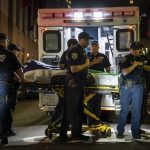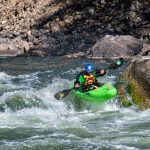Vail Daily health story: What to do if you’re first on the scene
Daily Correspondent

Dominique Taylor/Dominique Taylor Photography |
The Recovery Position
When a person becomes unconscious, death is not necessarily imminent. Place them in the recovery position to help boost their chances of survival:
Place the patient on their side or three quarters prone so that the mouth is down (allowing for secretions to drain out) and chin is up (keeping the airway open).
Limbs should be positioned to keep the patient in place. For example, the leg and arm not touching the ground is moved forward to act as a “kickstand” to keep the patient from laying completely face down on the ground.
Editor’s note: This story first ran in Vail Health magazine.
it’s all fun and games until someone pokes out an eye — or breaks a leg, hits a tree, trips over the cat, falls off a cliff … you get the idea. Accidents happen. When you’re the first person to show up after some mishap or other, you can make a big difference: You can help.
Dr. Gayle Braunholtz is a partner in the Vail Valley Emergency Physician Group, which staffs the emergency department at Vail Valley Medical Center. She’s also the medical director of Gypsum Urgent Care. It’s safe to say she knows a thing or two about injuries and sudden threats to a person’s well being.
At the top of the list, of course, is “call 911.” The sooner an ambulance crew is on the way, the better. Of course, there are times when seconds count and help is minutes away — and that’s where you come in. Here’s Braunholtz’s advice about what to do when you’ve got an injured person on your hands and you want to go beyond: First, do no harm.

Support Local Journalism
Bleeding wounds
Braunholtz said the best thing to do for a badly bleeding wound is applying direct pressure over the wound. That should at least slow the bleeding enough until help arrives.
“Don’t release pressure to check if the wound has stopped bleeding,” she said.
A tourniquet — a tightly wrapped bandage that stops all circulation between the wound and the heart — “should be reserved for a life-over-limb scenario,” she said. “A properly applied tourniquet becomes excruciatingly painful within 15 to 20 minutes,” and should be left to professionals whenever possible.”
Broken bones
With broken bones, the best way to assist is by helping someone stay still and as comfortable as possible — even in the case of a broken arm or wrist.
Braunholtz notes that broken bones have sharp edges that can poke through the skin, or worse — sever an artery or nerve. A makeshift splint can help stabilize a broken bone.
While moving a broken-bone patient as little as possible is always advisable, there are exceptions — if someone is head-down in a tree well, or in the middle of a road, moving to safety is a good first step.
Burns
With burns, cold water is always a good idea. If a burn has broken the skin, try to find antibiotic ointment. Seeking medical help is advisable for any burn that completely circles an area — all the way around an arm, for instance — or any burn bigger than the palm of your hand.
Any burn can potentially get infected, but third degree burns are the most severe, and, in bad cases can require skin grafts.
Concussions
Concussions are a bit different, because the symptoms aren’t always outwardly obvious. Braunholtz said any time someone hits his or her head in a fall or other accident, there’s always a risk of concussion. Symptoms may not appear right away, but can include headache, nausea, blurred vision, decreased concentration or memory loss.
If you develop any of these conditions after hitting your head, Braunholtz’s advice is to seek medical attention.
“Concussions should not be taken lightly,” she explains. “These symptoms indicate that your brain was rattled. It needs time to recover.”
If you’re skiing or biking, that means avoiding the risk of further falls for at least one to two weeks after being symptom-free. The consequences of a second injury can be dire:
“A second injury too soon after a first injury can lead to chronic headaches, cognition problems, and, in some instances, even permanent disability or death.”
In the case of progressive injury cycles, you don’t have to be old or infirm to suffer a stroke or heart attack — it’s far more common than you think for young, healthy adults to be hit by either one.
Strokes
A stroke — the sudden loss of blood to the brain — can be a bit like a concussion, in that the symptoms aren’t immediately apparent. But with strokes, the quicker someone gets help, the better.
There are any number of stroke symptoms, including garbled speech and numbness on one side of the body.
Braunholtz said the “Cincinnati prehospital stroke scale is a quick and easy way to screen someone for signs of stroke.”
The tests include:
• Ask the person to smile and show his or her teeth.
• Have the person close his eyes and hold his hands palms up and outstretched in front of him.
• Ask the person to say, “You can’t teach an old dog new tricks.”
The smile should be symmetric, the arms shouldn’t drift down and the patient shouldn’t have difficulty with this phrase. If all three signs are abnormal the chance of the person having a stroke is greater than 85 percent.
Again, call 911 immediately, make the person comfortable and get the person to a hospital as quickly as possible. The sooner the patient receives a blood clot-busting medicine called “tPA” the better.
Heart attack
Which leads us to the toughest of all emergencies — sudden cardiac arrest. If someone collapses in front of you, check for consciousness and call 911. If there is any chance that they are breathing, place them in the recovery position. This will protect their airway while they are unconscious. Thousands of fatalities occur every year in cases where the cause of the unconsciousness was not fatal but airway obstruction led to suffocation. See box for info on the recovery position.
Many public and private buildings have “automated external defibrillators,” or devices that will shock a person’s heart back to action. If one of those isn’t available, there’s the age-old standby — cardiopulmonary resuscitation, or CPR. Classes are available for free through Starting Hearts (www.startinghearts.com). A basic class takes three to four hours and could save a life.
You don’t have to be a doctor, a nurse or a member of an ambulance crew to help someone in need. Taking even basic action could help save a life.










